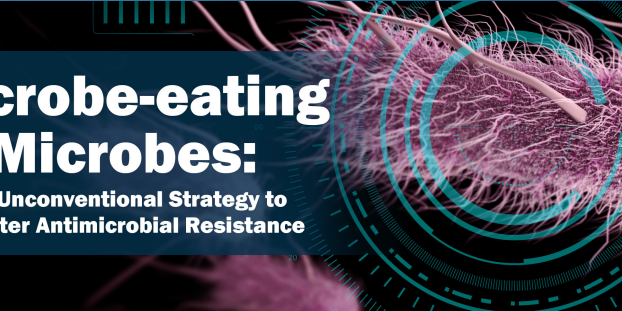Global antimicrobial resistance is on the rise [1]. Antimicrobial resistance affects warfighters and military personnel both on the battlefield and off. Combat wounds can be contaminated with environmental bacteria, such as S. aureus, that may confer resistance to conventional antibiotics. This was demonstrated in 2008, when multi-drug resistant bacteria were cultured from the wounds of soldiers who suffered injuries in Iraq and Afghanistan [2]. Antibacterial resistance has challenged military medicine since the discovery of penicillin. However, the situation today is compounded by the fact that no new antibiotic classes have been discovered since 1984 [3]. The U.S. Centers for Disease Control and Prevention calls this “one of the biggest health challenges of our time,” and the World Health Organization cautions that a possible “post-antibiotic era” is on the horizon [4, 5].
Drug Resistance
Drug resistance stems from the inherent variation within a species of microbes and is an unfortunate consequence of natural selection. Antibiotics eliminate susceptible bacteria, while resistant pathogens are refractory and continue to propagate. No small molecule-based drug bows to the selective pressures of biology—meaning there is no fundamental driving force or mechanism for a drug to co-evolve alongside a rapidly changing organism. As a result, drugs that target fast-evolving microbes quickly lose their efficacy with time.
Pathogen Predators
Instead of targeting microbes with drugs, can microbes be used to target other microbes? This question spurred the creation of the Pathogen Predators program launched by the Defense Advanced Research Projects Agency (DARPA) [6]. The Pathogen Predators program aims to develop dynamic therapeutics that use live, motile, predatory bacteria that prey upon other gram-negative bacteria that are pathogenic to humans [6]. This approach is highly advantageous in that predatory bacteria continuously evolve to maintain a competitive edge over their prey. In 2015,
DARPA and the U.S. Army Research Office awarded Dr. Daniel Kadouri (Rutgers School of Dental Medicine) $7.2 million to identify and characterize novel predatory bacteria that could be used to counter antimicrobial resistance [7]. To this end, Dr. Kadouri and his team studied the bacterial predator B. bacteriovorus.
Predators in Action
B. bacteriovorus parasitizes gram-negative bacteria and consumes them from within. This bacterium exhibits a broad range in prey and is not cytotoxic to five different human cell lines [8]. Although B. bacteriovorus is unable to target gram-positive bacteria, it does degrade gram-positive bacterial biofilms to obtain amino acids for energy and protein synthesis [9]. The capacity of B. bacteriovorus to eat gram-negative bacteria and weaken the defenses of gram-positive bacteria is a stunning display of evolution by natural selection at the microscopic level.
To characterize the therapeutic potential of this strategy, Dr. Kadouri and his team sought to determine if B. bacteriovorus could reduce the bacterial burden of the causative agent of plague, Y. pestis, in a mouse model of pulmonary plague. The authors found that three treatments of B. bacteriovorus introduced every six hours reduced the number of CFUs of Y. pestis in the lungs of inoculated mice by 86 percent after 24 hours of infection [10]. These results, in conjunction with preliminary safety studies, suggest that B. bacteriovorus may be used to target other gram-negative bacteria in vivo.
Conclusion
Antimicrobial resistance poses a significant problem for warfighters and military personnel around the world. The current lack of antibacterial drugs in the developmental pipeline has placed a burden on civilian and military health care facilities and cultivated the rise of multi-drug resistant pathogens. Predatory pathogens that target disease causing bacteria could provide a sustainable solution that complements the deficits associated with current antibiotic drugs and may help protect warfighters on the battlefield.
REFERENCES
1. Zaman, S., Hussain, M., Nye, R., Mehta, V., Mamun, K., & Hossain, N. (2017). A Review on Antibiotic Resistance: Alarm Bells are Ringing. Cureus, 9(6), e1403. doi: 10.7759/cureus.1403
2. Calhoun, J., Murray, C., & Manring, M. (2008). Multidrug-resistant Organisms in Military Wounds from Iraq and Afghanistan. Clinical Orthopaedics And Related Research, 466(6), 1356-1362. doi: 10.1007/s11999-008-0212-9
3. Silver, L. (2011). Challenges of Antibacterial Discovery. Clinical Microbiology Reviews, 24(1), 71-109. doi: 10.1128/cmr.00030-10
4. Antibiotic Resistance Threatens Everyone. (2019). Retrieved from https://www.cdc.gov/drugresistance/index.html
5. WHO’s first global report on antibiotic resistance reveals serious, worldwide threat to public health. (2019). Retrieved from https://www.who.int/mediacentre/news/releases/2014/amr-report/en/
6. Ringeisen, B. Pathogen Predators. Retrieved from https://www.darpa.mil/program/pathogen-predators
7. Stetler, C. (2015). Rutgers Researcher Receives $7.2 Million from Military to Fight Drug-Resistant Bacteria. Retrieved from https://news.rutgers.edu/research-news/rutgers-researcher-receives-72-million-military-fight-drug-resistant-bacteria/20150628#.XGc_FLh7lhF
8. Gupta, S., Tang, C., Tran, M., & Kadouri, D. (2016). Effect of Predatory Bacteria on Human Cell Lines. PLOS ONE, 11(8), e0161242. doi: 10.1371/journal.pone.0161242
9. Im, H., Dwidar, M., & Mitchell, R. (2018). Bdellovibrio bacteriovorus HD100, a predator of Gram-negative bacteria, benefits energetically from Staphylococcus aureus biofilms without predation. The ISME Journal, 12(8), 2090-2095. doi: 10.1038/s41396-018-0154-5
10. Russo, R., Kolesnikova, I., Kim, T., Gupta, S., Pericleous, A., Kadouri, D., & Connell, N. (2018). Susceptibility of Virulent Yersinia pestis Bacteria to Predator Bacteria in the Lungs of Mice. Microorganisms, 7(1), 2. doi: 10.3390/microorganisms7010002


